How do community mobility and the difference of BCG strains effect the spreading of COVID-19?
This is a further analysis with regard to the previous article.
(文章が長いので、先にサマリーのみ日本語で記載します)
ざっくりいえば、BCGワクチン(特にTokyo株種)ならびに早期の社会的隔離施策の2つが、コロナ拡散の抑止に効きそうという内容です。
▼BCGワクチンのカバー率によって、感染者数と死亡者数の倍加時間が違う
▼BCGワクチンの中でも、BCG Tokyo株種の効果は強いようにみえる
▼早期に社会的隔離政策を入れることは、主に感染者数の倍加時間に正の影響を与える
▼感染者数の倍加時間を高めるために、地域の活動量をどのくらい落とす必要があるかは、国ごとによって異なる(50%ー80%が多いが、30%程度のところもある)
▼遅い、緩い社会的隔離政策は、上記のBCGワクチン(Tokyo株種)の影響を相殺する可能性がある
The dashboard I show in this article is available in the Tableau Public site.
この記事にあるダッシュボードは、以下のTableau Publicサイトで利用できます。是非とも、さわってみてください。
In the previous article, I mentioned the findings below.
▼No BCG vaccination coverage makes both DT(doubling time) of # of deaths and that of confirmed cases keep low for more than 20 days from the "starting date" (that means # of deaths per capita exceeds a certain number in each country.)
▼BCG Tokyo strain seems to make DT of # of deaths higher during certain period of 10 to 15 days.
▼BCG Tokyo strain seems to make DT of # of deaths higher at the early days of the virus spreading.
A challenge in the previous article was that I didn't take the social distancing policy into account, which seems to have positive impact on DT in confirmed cases.
Google offers us the community mobility data, which gives us the visibility of the direct effect of social distancing policy in each city/country.
In this article, I would like to analyze the relationship between the community mobility and DT in confirmed cases as well as the relationship between DT in confirmed cases and DT in deaths.
I take the BCG vaccination policy into account and categorize countries in four segments, which are "No coverage", "Covered less than 50%", "Covered over 50% with Non-Tokyo stain" and "Covered over 50% with Tokyo stain."
▼"No coverage": No mandatory BCG vaccination policy has been adopted.
▼"Covered less than 50%" : Mandatory BCG vaccination is currently implemented or was implemented in the past, which covers less than 50% of the population.
▼"Covered over 50% with Non-Tokyo strain" : Mandatory BCG vaccination is currently implemented or was implemented in the past, which covers over 50% of the population, with Non-Tokyo(Denmark, Moreau, Russia ...) strain.
▼"Covered over 50% with Tokyo strain" : Mandatory BCG vaccination is currently implemented or was implemented in the past, which covers over 50% of the population, with Tokyo strain.
I also take the nationwide social distancing policy into account, and I divide each segment above into two respectiv, which are "Early quarantine" and "Late quarantine" by # of confirmed deaths of the day when the nationwide social distancing policy become effective, is over 50 (Late) or not (Early).
[How to calculate the params]
▼The change of community mobility in each country
Google offers us the change of community mobility in several place categories, compared with "the baseline of the median value, for the corresponding day of the week, during the 5-week period Jan 3–Feb 6, 2020." (In detail, see the document)
I use this data and calculate the average of Grocery & pharmacy, Parks, Transit stations, Retail & recreation and Workplaces in the country.
▼How to calculate the other params are the same as the previous article
[Premises on this analysis]
▼I picked up top 30 countries in terms of # of confirmed cases as of Apr. 18th. In the segment of "Covered over 50% with Tokyo strain", I picked up top 70 countries so that we could have more data-sets.
[Data sources]
▼Google: The community mobility data
▼The other data sources are the same as the previous article.
Here's the result.
["No BCG coverage" segment in top 30 countries]

The left figure shows the chronological change in DTs, which are DT in confirmed cases (X-axis) and DT in deaths (Y-axis).
The right figure shows the chronological change in the mobility (X-axis, compared with the baseline period from Jan. 3rd to Feb. 6th) and in DT in confirmed cases (Y-axis).
The numbers (e.g. 10) in these figures shows the days from the starting day when # of deaths per capita (per 100M) becomes a certain number in each country. (In this analysis, this param is set as 15.)
The middle-size dots(●) in these figures show the day when the nationwide social distancing policy becomes effective in each country. (The definition of this date is the same as this article)
I divide this segment into two, which are "Early quarantine" and "Late quarantine"
["No BCG coverage" and "Early quarantine" segment in top 30]

["No BCG coverage" and "Late quarantine" segment in top 30]
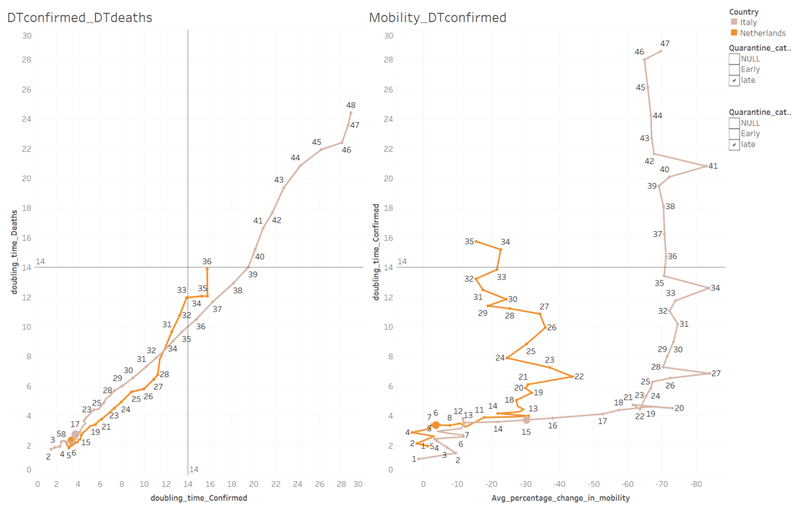
Findings
▼No BCG vaccination coverage makes DT in confirmed cases become 14 (2 weeks to double) after more than 30 days.
▼It takes about 10 to 15 days for DT in confirmed cases in each country to increase, after introducing its nationwide social distancing policy.
▼The degree of reducing community mobility varies country to country from around 20-40%(US, Canada, Netherlands) to 70-80%(Italy, Belgium).
▼No BCG vaccination coverage makes DT in deaths become 14 (2 weeks to double) after more than 35 days.
["Covered less than 50%" segment in top 30 countries]**
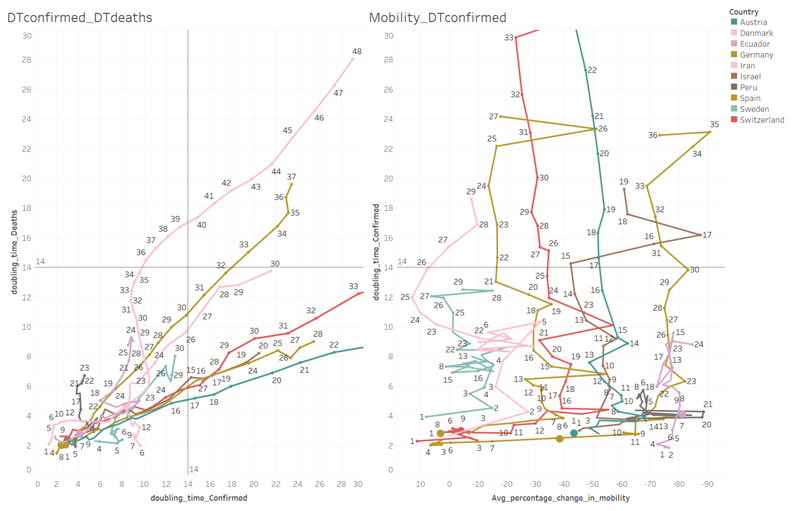
Dividing this into "Early quarantine" and "Late quarantine",
["Covered less than 50%" and "Early quarantine" segment in top 30]
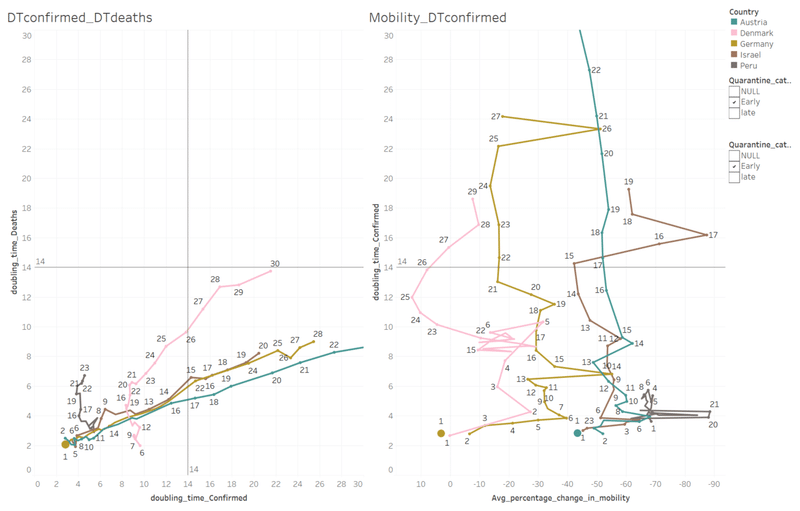
["Covered less than 50%" and "Late quarantine" segment in top 30]

Findings
▼Early quarantine in this segment makes DT in confirmed cases possible to become over 14 (2 weeks to double) in 15 to 30 days. whereas late quarantine makes DT in confirmed cases become over 14 in 25 to 30 days or more. Early quarantine seems to matter in this segment.
▼The degree of reducing community mobility to increase DT in confirmed cases varies country to country.
▼DT in deaths become over 14 (2 weeks to double) after 30 days.
["Covered over 50% with Non-Tokyo strain" segment in top 30 countries]**

Dividing this into "Early quarantine" and "Late quarantine",
["Covered over 50% with Non-Tokyo strain" and "Early quarantine" segment in top 30]

["Covered over 50% with Non-Tokyo strain" and "Late quarantine" segment in top 30]
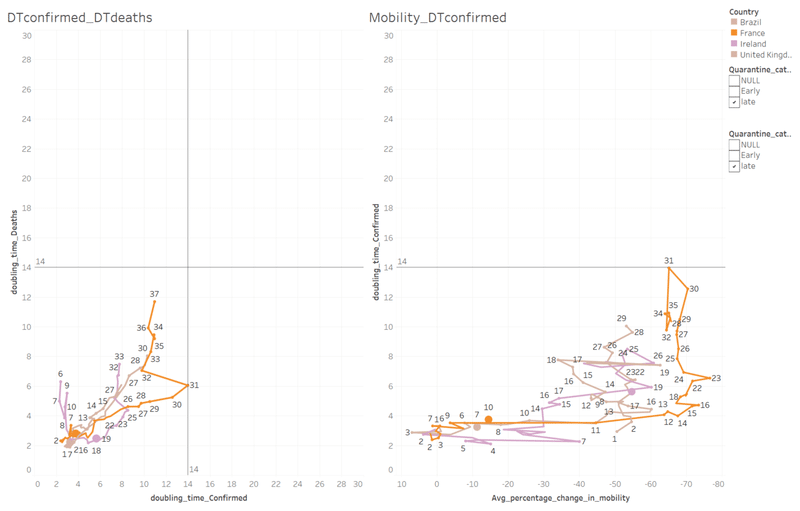
Findings
▼Early quarantine in this segment makes DT in confirmed cases possible to become over 14 (2 weeks to double) in 15 to 25 days. whereas late quarantine makes DT in confirmed cases become over 14 after 30 days. Early quarantine also seems to matter in this segment!
▼The degree of reducing community mobility to increase DT in confirmed cases varies country to country.
▼In some countries which introduce early quarantine successfully (Korea and China), DT in deaths become over 14 (2 weeks to double) in around 20 days. (On day 20, DT in deaths is 15 in China and 13 in Korea)
▼For the other countries, DT in deaths become over 14 (2 weeks to double) after 30 days.
["Covered over 50% with Tokyo strain" segment in top 70 countries]**
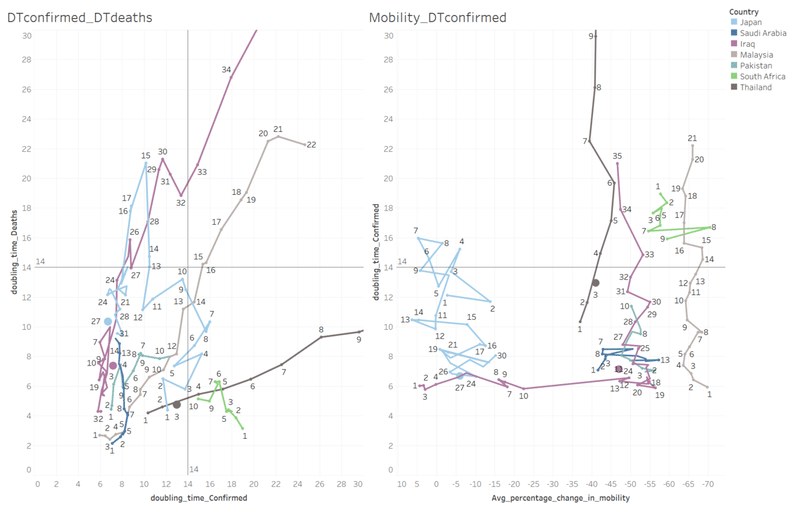
Dividing this into "Early quarantine" and "Late quarantine",
["Covered over 50% with Tokyo strain" and "Early quarantine" segment in top 70]
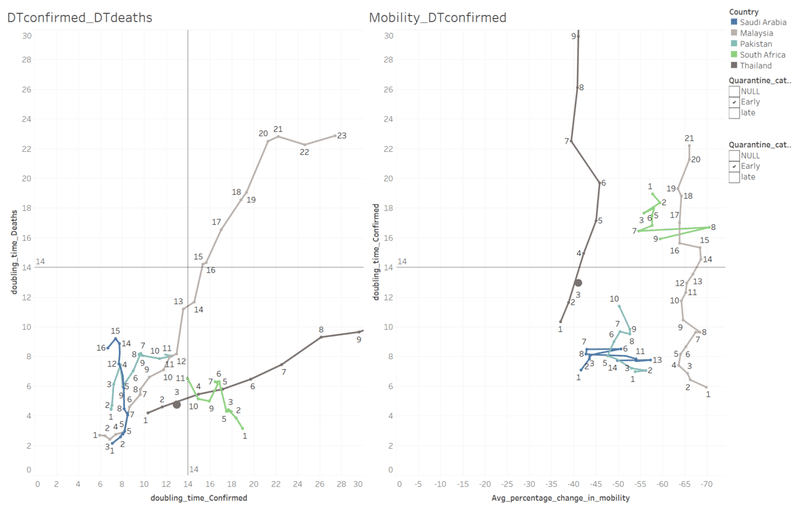
["Covered over 50% with Tokyo strain" and "Late quarantine" segment in top 70]
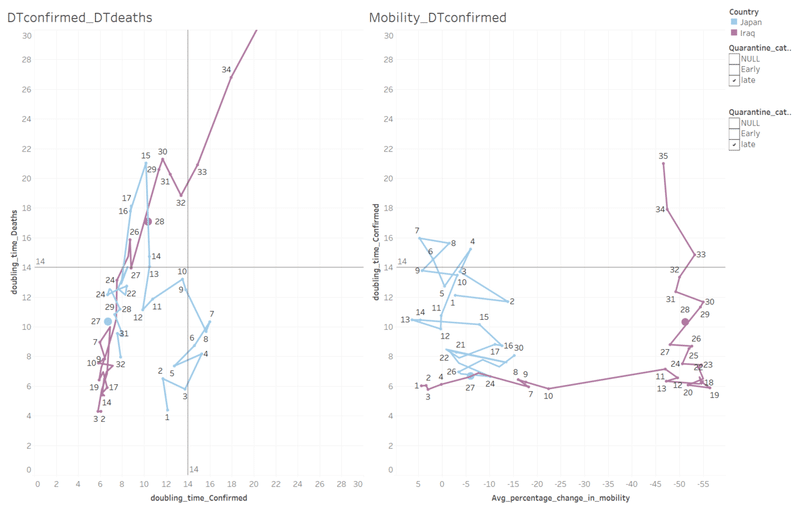
Findings
▼One of the most remarkable features is the high DT in confirmed cases on Day 1, many of them starts around 6, irrespective of the community mobility.
▼Another remarkable feature is the increase of DT in deaths in early days. You can see the lines in the left figures go up in early days (day 1 to day 10), which cannot be seen in other segment.
▼Early quarantine in this segment makes DT in confirmed cases possible to become over 14 (2 weeks to double) in 5 to 15 days, whereas late quarantine makes DT in confirmed cases become over 14 after 30 days. Early quarantine also seems to matter in this segment!
▼Early quarantine in this segment makes DT in deaths possible to become over 14 (2 weeks to double) after 15 days, whereas late quarantine makes DT in confirmed cases become over 14 after 25 days.
▼Even in those countries with BCG Tokyo strain, late or loose quarantine might offset the positive effect of the strain.
[Conclusion]
I summarize the days for DTs to become 14 ( 2 weeks to double) in each category.
Upper case in each cell show the days for DT in confirmed cases to become 14 (2 weeks to double.) (Unit: days)
Lower case in each cell show the days for DT in deaths to become 14 (2 weeks to double.) (Unit :days)

Conclusion is as follows.
▼BCG vaccination has positive effect on both of DT in confirmed cases and DT in deaths.
▼BCG Tokyo strain seems to have more impact on DTs than the other strains.
▼Early quarantine has positive effect on DT in confirmed cases in most segments, while having less effect in "No coverage" segment. (But it doesn't mean that the early quarantine is unnecessary, because it might have got worse without it.)
▼The degree of reducing community mobility to increase DT in confirmed cases varies country to country.
▼Late or loose quarantine might offset the positive effect of BCG vaccination even though it is covered with BCG Tokyo strain. (Japan is now struggling...)
Further discussion and analysis might be as follows.
・Medical verification should be conducted before any actions based on this hypothesis are taken.
・I don't include the medical capacity in each country, which could impact on # of deaths in a rapid spreading situation.
Bunshiro Ochiai
I declare no conflicts of interest associated with this report.
この記事が気に入ったらサポートをしてみませんか?
